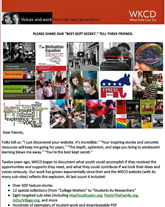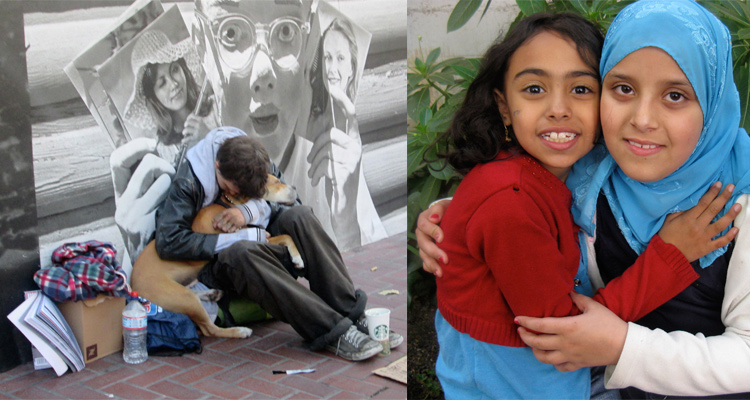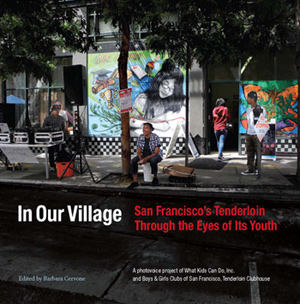OTHER WKCD WEBSITES SPECIAL COLLECTIONS Students as Allies in School POPULAR WKCD PUBLICATIONS (PDFS] A Guide to Creating Teen- Cultural Conversations through Creative Writing Documenting Immigration Stories First Ask, Then Listen: How Your Students Can Help You Teach Them Better Making Writing Essential to Profiles of Politically Active Youth Queer Youth Advice for Educators The Schools We Need: Creating Small High Schools That Work for Us
| San Francisco's Tenderloin Through the Eyes of Its Youth by Barbara Cervone | AUGUST 11, 2015
Photos credits: (L) "Hope," Lucily Chel, 17; (R) "Friends," Somiah Yahya, 13
In San Francisco’s Tenderloin district, everyone has a story to tell. Long home to the city’s homeless and mentally ill, the Tenderloin also pulses with immigrants upended by turmoil in their native country. Here, among the single-occupancy hotels, a family of five can squeeze into two small rooms and make a fresh start. This is the poorest and most densely packed neighborhood in San Francisco. It also has the highest concentration of children under 18 anywhere in the city. In this new book from WKCD and Next Generation Press, youth from the neighborhood share their stories. All members in the Tenderloin Clubhouse at Boys & Girls Clubs of San Francisco (BGCSF), they provide a vivid portrait of growing up in a neighborhood many shun. Their photographs and words will open your eyes and hearts.
“Most of us were born in the Tenderloin, but our parents and grandparents, our aunts and uncles were not,” begins Naim, a teen leader at the Clubhouse. Naim’s parents are from Yemen. John’s parents are Chinese but met in a Vietnamese prison camp. Nine-year-old Marco’s parents are from Mexico. “They moved here because they wanted a better job. Here, my dad works making marbles and my mom works cleaning houses,” he says. In Our Village: San Francisco’s Tenderloin Through the Eyes of Its Youth takes us on a tour of the subjects that matter most to its authors, from feelings of belonging or learning to swing a baseball bat to technology in San Francisco’s least wired neighborhood. The sacrifice and hard work of their parents form a steady beat. “Our success will make their journey and all of their sacrifices right,” says high school senior Albert, whose family comes from Vietnam. “We carry this knowledge with us every day.” He will be the first in his family to attend college. “We stand on our parents’ shoulders, and they stand on ours.” Tolerance runs deep. When Naim’s non-Tenderloin friends visit him, they “go paranoid” at all the human variety, he says. But he sees it as a blessing. “Growing up here has made me more open and aware,” he says. “I’m a better person for it.The community is stronger too.” On the subject of food, opinions flow. Which tastes better, pupusas or samosas, pho or falafel, the book’s young contributors debate. Who likes mac and cheese, popcorn, bacon? Is American food good for you? For kids growing up in the Tenderloin, there’s what you eat at home (maybe carne asada or kimchi), what you find in the small ethnic restaurants (a rare treat for these kids), federal breakfast and lunch, donated food, and snacks. There’s agreement on one thing: in a neighborhood marked by hunger, the food can be delicious. When it comes to safety, 13-year-old Maria will tell you: “The homeless man staring up from the sidewalk may look scary, but he means no harm. The people lined up outside the soup kitchen, they may cause you to look away, but they aren’t dangerous.” Living where the violent crime rate is the highest in the city, the book’s young authors have learned to size up danger. They’ve also contributed sidewalk drawings to the Tenderloin “Safe Passages” program, which protects kids on their way to and from afterschool programs. Most of all, though, the youth whose photos and voices fill this book brim with optimism.
More about this project San Francisco’s Tenderloin through the Eye of Its Youth is rooted in a photovoice program that brought together teenagers from the Boys & Girls Clubs of San Francisco-Tenderloin Clubhouse and two other neighborhood groups (the Vietnamese Youth Development Center and the Central YMCA) in the summer of 2013. Working with a professional photographer, participants documented the world close at hand: a homeless man embracing his dog, three transvestites standing on a corner, the lights of a liquor store at night. The resulting exhibit, “Ain’t Nothin’ Tender Here,” turned heads at the San Francisco gallery where it debuted. For this project, Clubhouse youth worked with WKCD's Barbara Cervone to create a museum-quality book about growing up in the Tenderloin—including the tender parts, too. For a decade, WKCD has partnered with youth worldwide to document daily life in their “village,” from rural Tanzania to North Hollywood. In Our Village: San Francisco’s Tenderloin through the Eyes of it Youth joins this series. “No doubt, the young people who have contributed to this volume will move on and out of the Tenderloin,” says the Tenderloin Clubhouse’s director, Esan Looper, who himself grew up in the neighborhood. “This is why their parents came to America: to give their children opportunities they could barely imagine. Wherever they go, though, I bet these young people take with them all they learned growing up in the Tenderloin, lessons they won’t find anywhere else.” Why is San Francisco's Tenderloin called the Tenderloin? "There are a number of stories about how the Tenderloin got its name. One says it is a reference to an older neighborhood in New York with the same name and similar characteristics. Another is a reference to the neighborhood as the 'soft underbelly' (analogous to the cut of meat) of the city, with allusions to vice and corruption, especially graft. There are also some legends about the name, probably folklore, including that the neighborhood earned its name from the words of a New York City police captain, Alexander S. Williams, who was overheard saying that when he was assigned to another part of the city, he could only afford to eat chuck steak on the salary he was earning, but after he was transferred to this neighborhood he was making so much money on the side soliciting bribes that now he could eat tenderloin instead. Another version of that story says that the officers who worked in the Tenderloin received a 'hazard pay' bonus for working in such a violent area, and thus were able to afford the good cut of meat. Yet another story, also likely apocryphal, is that the name is a reference to the 'loins of prostitutes.'" - Lillan Smith, Wikipedia Do you know a group of youth who would enjoy the challenge of capturing images and stories about their "village?" Please contact info@wkcd.org.
What Kids Can Do, Inc. | info@whatkidscando.org | www.whatkidscando.org
|




